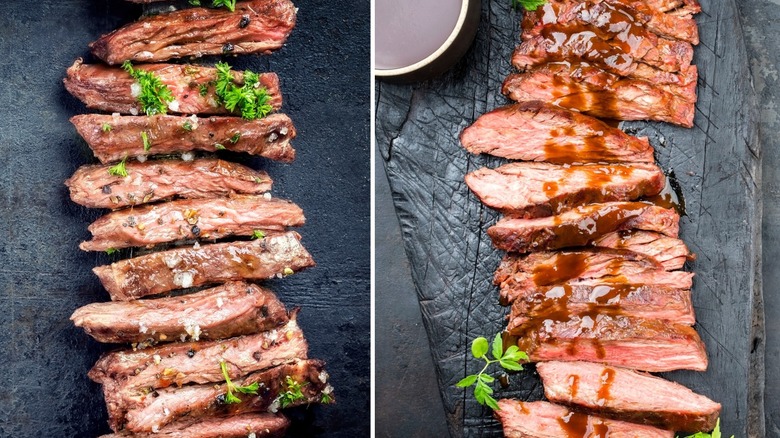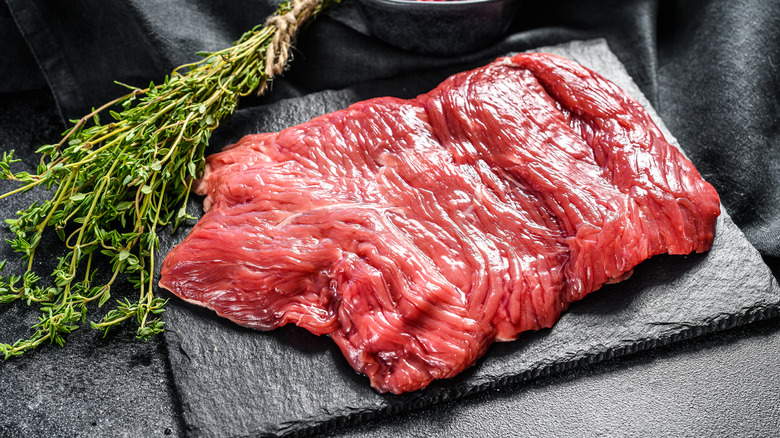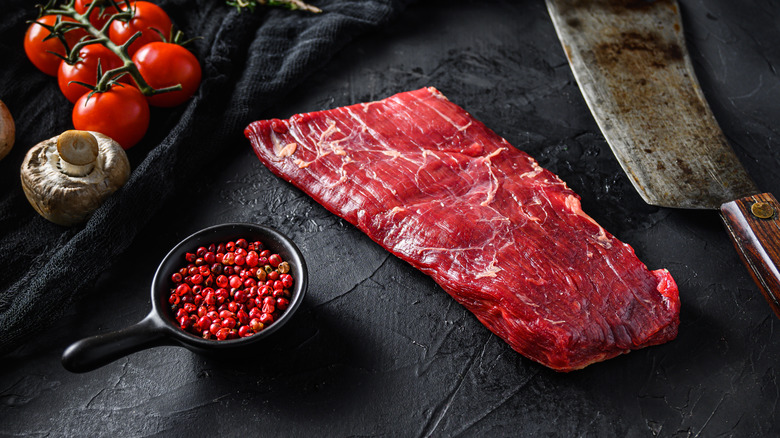Skirt Vs Flank Steak: What's The Difference?
Skirt steak and flank steak have a lot in common. They look similar, taste similar, and can be used for many of the same culinary purposes. They've also both followed a similar, rather remarkable journey in recent years. Skirt and flank steak were long considered undesirable, to the point that they were sometimes discarded as scrap meat. This is due to the fact that both cuts have a tendency to become very tough if you don't cook them just right. Fortunately, people have come around to the proper cooking methods, and when done right, skirt steak and flank steak provide arguably more flavor for your dollar than any other cut of beef.
The similarities between skirt steak and flank steak begin with their appearance — both are thin, flat cuts with prominent muscle fibers. They are very lean, and the lack of fat paired with the large muscle fibers can make the meat tough unless you tenderize it first, which is best done by marinating. Both cuts do best with high-and-fast cooking methods like grilling, and they can be used for many of the same dishes, being particularly popular for fajitas and tacos.
The biggest differences between flank steak and skirt steak are their size, with the flank being thicker but shorter than the skirt, as well as the arrangement of the muscle fibers and fat. These subtle differences have a significant impact on cooking time and texture.
What is skirt steak?
Skirt steak is cut from the plate section of the cow, which comprises the central belly region just below the rib cut. The plate is also the source of short ribs and the prized hanger steak, which is another flat cut somewhat similar to skirt and flank. Hanger steak is also known as "skirt steak" in the United Kingdom, which can cause some confusion between the cuts. The American version of skirt steak can also be known as Philadelphia steak, Romanian steak, and arrachera.
Each cow actually gives two skirt steaks, known as the "inside" and "outside" skirts. Inside skirt steak comes from the transversus abdominis muscle, which is located inside the ribs, while the outside skirt steak comes from the diaphragm muscle, located outside the ribs. Outside skirt steak is thicker and more tender, but butchers typically sell it directly to restaurants, so it can be hard for home cooks to find. If you do happen to come across an outside skirt steak at your local butcher, it should be your first choice, but the inside skirt still has a lot to offer, and with the proper cooking technique, you can barely tell the difference.
Skirt steak is a bit more flavorful than flank steak, and slightly fattier. It is longer and thinner than flank steak, and the muscle fibers are less dense, which allows marinades to better penetrate the meat for both tenderness and flavor.
What is flank steak?
A big part of the confusion between flank and skirt steaks is that the flank is sometimes referred to as "skirt steak" itself, even though it is a completely different cut than the other skirt steak. To clarify, flank steak comes from the cow's lower abdomen, between the plate and the hind legs. Flank and skirt steaks both weigh the same, typically coming in between one and two pounds; however, they distribute that mass differently. Flank steak is shorter than skirt steak, but thicker — up to an inch thick, which is twice as much as the average skirt steak.
By virtue of its thicker nature, flank steak takes longer to cook than skirt steak. Despite this, flank steak should actually be cooked to a lesser doneness than skirt steak. If the flank goes beyond medium-rare (130-135 degrees Fahrenheit), it will be very tough, whereas skirt steak, which has a bit more fat to keep it tender, can go up to medium (135-140 degrees).
The muscle fibers in flank steak are more densely packed than those in skirt steak, which makes it more difficult for marinades to soak in. Thus, flank steaks typically need to marinate for longer. Both flank and skirt steaks should be cut against the grain, but since the muscle fibers in flank steak run shortways and those in skirt steak run longways, slices of flank steak will be shorter than slices of skirt steak.


